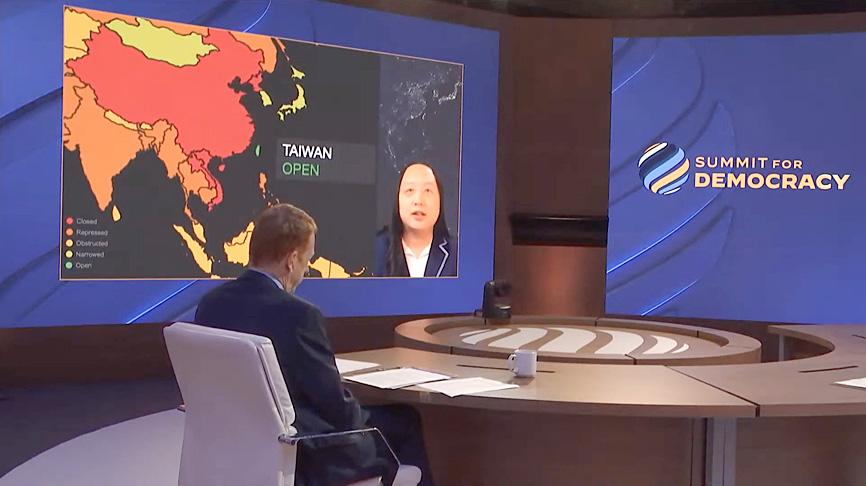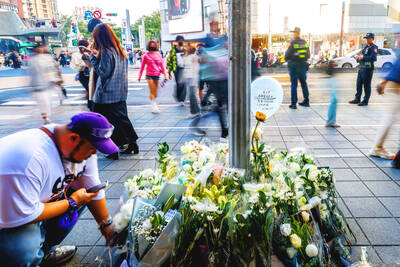A video feed of a Taiwanese minister was cut during US President Joe Biden’s Summit for Democracy last week, after a map in her slide presentation showed Taiwan in a different color to China.
Friday’s slide show by Minister Without Portfolio Audrey Tang (唐鳳) caused consternation among US officials after the map appeared in her video feed for about one minute, sources familiar with the matter said.
The sources, who did not want to be identified due to the sensitivity of the matter, said the video feed showing Tang was cut during a panel discussion and replaced with audio only — at the behest of the White House.

Screen grab from a Summit for Democracy livestream
The White House was concerned that differentiating Taiwan and China on a map in a US-hosted conference — to which Taiwan had been invited in a show of support at a time when it is under intense pressure from Beijing — could be seen as being at odds with Washington’s “one China” policy, which avoids taking a position on whether Taiwan is part of China, the sources said.
The US Department of State said “confusion” over screen-sharing resulted in Tang’s video feed being dropped, calling it “an honest mistake.”
“We valued Minister Tang’s participation, which showcased Taiwan’s world-class expertise on issues of transparent governance, human rights and countering disinformation,” a spokesperson said.
Tang’s presentation included a color-coded map from South African non-governmental organization Civicus, ranking the world by openness on civil rights.
Most of Asia was shown, with Taiwan colored green, making it the only regional entity portrayed as “open,” while all the others, including several US allies and partners, were labeled as being “closed,” “repressed,” “obstructed” or “narrowed.”
China, Laos, North Korea and Vietnam were colored red and labeled “closed.”
When the moderator returned to Tang a few minutes later, there was no video of her, just audio, and a screenshot captioned: “Minister Audrey Tang Taiwan.”
An onscreen disclaimer later read: “Any opinions expressed by individuals on this panel are those of the individual, and do not necessarily reflect the views of the United States government.”
The map generated an instant e-mail flurry among US officials and the US National Security Council (NSC) angrily contacted the state department, concerned it appeared to show Taiwan as a distinct country, one source said.
Washington complained to Taiwan’s government, which was angry that Tang’s video had been cut.
The source called the US move an overreaction as the map was not inherently about national boundaries, but the NSC was also angry as the slide had not appeared in “dry-run” versions of the presentation before the summit, raising questions as to whether there was intentional messaging by Tang and Taiwan.
“They choked,” the source said of the White House reaction.
A second source directly involved in the summit said the video booth operator acted on White House instructions.
“It was clearly policy concerns,” the source said. “This was completely an internal overreaction.”
The sources said they saw the move during a panel on “countering digital authoritarianism” as at odds with the summit’s mission of bolstering democracy in the face of challenges from China and others.
They also said it could signal that the administration’s support for Taiwan was not as “rock solid” as it has repeatedly stated.
Reuters’ account of the incident was “inaccurate,” an NSC spokesman said.
“At no time did the White House direct that Minister Tang’s video feed be cut,” the spokesman wrote in an e-mail, also blaming it on confusion over screen-sharing, and adding that the full video could be viewed on the summit Web page.
The Ministry of Foreign Affairs said yesterday that the US has blamed the incident on a “technical issue.”
Tang’s presentation had been provided in advance and was not shown at the last minute, the ministry said later.
“Taiwan and the United States have fully communicated on this technical issue, and the two sides have a solid mutual trust and a solid and friendly relationship,” it said.
Additional reporting by CNA

SHIPS, TRAINS AND AUTOMOBILES: The ministry has announced changes to varied transportation industries taking effect soon, with a number of effects for passengers Beginning next month, the post office is canceling signature upon delivery and written inquiry services for international registered small packets in accordance with the new policy of the Universal Postal Union, the Ministry of Transportation and Communications said yesterday. The new policy does not apply to packets that are to be delivered to China, the ministry said. Senders of international registered small packets would receive a NT$10 rebate on postage if the packets are sent from Jan. 1 to March 31, it added. The ministry said that three other policies are also scheduled to take effect next month. International cruise ship operators

HORROR STORIES: One victim recounted not realizing they had been stabbed and seeing people bleeding, while another recalled breaking down in tears after fleeing A man on Friday died after he tried to fight the knife-wielding suspect who went on a stabbing spree near two of Taipei’s busiest metro stations, Taipei Mayor Chiang Wan-an (蔣萬安) said. The 57-year-old man, identified by his family name, Yu (余), encountered the suspect at Exit M7 of Taipei Main Station and immediately tried to stop him, but was fatally wounded and later died, Chiang said, calling the incident “heartbreaking.” Yu’s family would receive at least NT$5 million (US$158,584) in compensation through the Taipei Rapid Transit Corp’s (TRTC) insurance coverage, he said after convening an emergency security response meeting yesterday morning. National

PLANNED: The suspect visited the crime scene before the killings, seeking information on how to access the roof, and had extensively researched a 2014 stabbing incident The suspect in a stabbing attack that killed three people and injured 11 in Taipei on Friday had planned the assault and set fires at other locations earlier in the day, law enforcement officials said yesterday. National Police Agency (NPA) Director-General Chang Jung-hsin (張榮興) said the suspect, a 27-year-old man named Chang Wen (張文), began the attacks at 3:40pm, first setting off smoke bombs on a road, damaging cars and motorbikes. Earlier, Chang Wen set fire to a rental room where he was staying on Gongyuan Road in Zhongzheng District (中正), Chang Jung-hsin said. The suspect later threw smoke grenades near two exits

The Forestry and Nature Conservation Agency yesterday launched a gift box to market honey “certified by a Formosan black bear” in appreciation of a beekeeper’s amicable interaction with a honey-thieving bear. Beekeeper Chih Ming-chen (池明鎮) in January inspected his bee farm in Hualien County’s Jhuosi Township (卓溪) and found that more than 20 beehives had been destroyed and many hives were eaten, with bear droppings and paw prints near the destroyed hives, the agency said. Chih returned to the farm to move the remaining beehives away that evening when he encountered a Formosan black bear only 20m away, the agency said. The bear